Subscribe now to get notified about IU Jharkhand journal updates!
Effectiveness of Health Care Service Sector related Public Service Print Media Advertising in Tripura, India
Abstract :
Management of the economics of public service advertising of health care service sector shall be followed very efficiently and effectively by any nation proactive to human beings or society in general. In this context the main objective of this study is to examine the effectiveness of Health Care Service Sector related Public Service Print Media Advertising in Tripura, India. This study is mainly based on the primary and secondary data. Primary data collected through pre-tested questionnaire and secondary data collected from the various sources like Published report, Web Articles, Journals and research report etc. Percentage analysis through table, pie-chart, bar diagram, Chi square (x2) tests, Phi & Cramer's V Value and Pearson Correlations were applied to test the research hypothesis with the help of SPSS. However, from the whole analysis of the study it can be strongly concluded that the public service advertising related to advertising on health care service sector through print media is effective and it is observed that all the study have provided some positive outcome and further expansion of field study frequently basis may give more effective and efficient social wellbeing’s.
Keywords :
Effectiveness, Public Service Ad, Health Care Industry, Print MediaIntroduction:-
In India Public service advertising related to health care service sector regularly carried out by the Central and State Government.
Some important health care service sector related public awareness campaign are Dengue, Women health, Smoking, Swine Flu, HIV / AIDS,
Don’t drink and drive, Anti-Alcohol , Cancer, Polio, Typhoid, Thalassemia, Drinking and smoking, Family Planning, Malaria, Iodine salt,
Immunization for kids in government Hospital etc.
To promote these philanthropic causes central and state government spends lot of money every year but it need to be measure that actually
these public service advertisement related to health care service sector produces what nature of effective and efficient result.
Methodology:
This study is mainly based on the primary and secondary data. Primary data collected through pre-tested questionnaire with sample size 240 covering all districts in Tripura and secondary data collected from the various sources like Published report, Web Articles, Journals and research report etc. Comparative study of this research have been done through the assessment of existing research report, articles related to the literature for the economics of public service advertising of health care service sector. Percentage analysis through table, pie-chart, bar diagram, Chi square (x2) tests, Phi & Cramer's V Value and Pearson Correlations were applied to test the research hypothesis with the help of SPSS.
Objectives of the study:
The research works is an attempt to investigate the effectiveness of Health Care Service Sector related Public Service Print Media Advertising in Tripura, India.
Formulation of hypotheses:
Based on the objectives of thesis, the following main hypotheses were formulated to know the association between overall health care service sector related public service advertising observation experiences and general socio-economic characteristics of respondents in the study area.
- There is relationship between general socio-economic characteristics of respondents and overall health care service sector related public service advertising observation experiences in the study area (are associated).
- There is relationship between general socio-economic characteristics of respondents and overall health care service sector related public service advertising published in the print media observation experiences in the study area.
Literature review:-
In order to build up a appropriate perception of the research problem recognition and to expand a theoretical structure to carry out the assessment of existing literature for the economics of public service advertising of health care service sector from the secondary sources, the following literature have been reviewed.
Martin S (2016) article on Word-of-mouth in the health care sector: a literature analysis of the current state of research and future perspectives revels that Word-of-mouth (WOM) might spread in networks and influence large groups of people, stakeholder theory further proposes considering Word-of-mouth (WOM) as a possible way to distribute specific health care recommendations.
Islam M., Sheikh S. (2016) study on college students revels that in Korea students pay much more attention on clarity of the emotional advertisements and found more effective in changing people mind to quit smoking and recommended that Government should play vital role to select emotional ads and broadcast frequently to reduce number of smoker and improve health condition of its citizen.
Hinde S et al. (2015) Concluded that Subject to the accessible proof, the analysis on Modeling the cost-effectiveness of public awareness campaigns for the early detection of non-small-cell lung cancer advocates that early consciousness movements in lung cancer have the possibility to be cost-effective. In addition to that the projected ordinary history model presents before was unavailable to forecast of the occurrence and speed of disease development in the undiagnosed populace.
Hsu et al. ( 2012) study on Comparative costs and cost-effectiveness of behavioral interventions as part of HIV prevention strategies suggests that while individual involvements are an attractive use of resources to raise awareness, this may not translate into a cost-effective impact on behavior change. The study found that the extensive reach of public outreach events did not seem to influence behavior change as cost-effectively when compared with magazines or radio broadcasts. Behavioral interventions are context-specific and their effectiveness influenced by a multitude of factors. Further analyses using a quasi-experimental design would be useful to programme implementers and policy makers as they face decisions regarding which HIV prevention activities to prioritize.
Bora (2010) has mentioned that Promoting significant social concerns which normally go ignored, public service advertising is well thought-out to be one of the most effective way to generate and nurture social awareness and bring about a transformation.
Data Analysis, Results and Discussions:
General socio-economic characteristics of respondents in the Study area
Background:
This part mainly deals with the socio economic profile of the 240 sample respondents from all districts in Tripura, India. It is based on the analysis of field level study data collected in the year 2017 and 2018. As stated earlier, all districts in Tripura, India namely West Tripura district, Sipahijala district, Dhalai district, North Tripura district, Gomati district, Khowai district, Unakoti district, and South Tripura district were selected for the study. As the study is focused on the effectiveness of the economics of the selected public service advertising of health care service sector in Tripura, India covering the area or subject matter like the effectiveness of the economics of selected health care service sector related public service outdoors advertising, influence of health care service sector related public service television advertising in electronic media and its effect in pursuing the announcement made for public cause in Tripura, influence of health care service sector related public service print media advertising and its effect in pursuing the announcement made for public cause in Tripura, overall reach of the recent government sponsored health care service sector related public service advertising among public in Tripura and right media for telecasting the health care service sector related public service advertising to make it more effective, hence in this regard collection of the socio economic profile sample respondents are essential. Further, sixteen demographic variables and socio-economic characteristics of respondents considered for the study are gender of the respondents, age of the respondents, education, category or caste, nature of family, occupational status, marital status, resident location, Public service advertising observation experiences related to advertising on health care service sector, Health care service sector related public service advertisement telecasted in television observation experiences, Health care service sector related public service advertising published in the print media observation experiences, health care service sector related public service advertising given in outdoor media observation experiences, family monthly income, annual expenditure, land ownership in area and types of property holding has been discussed here.
Gender of the Respondents:
Table 1 specifies that, most of the respondents were male married (37.1%) and unmarried (33.3%). The percentage of the female married and female unmarried was 15.4 percent and 12.9 percent respectively. The percentage of the Transgender and Widow was 0.4 percent each.
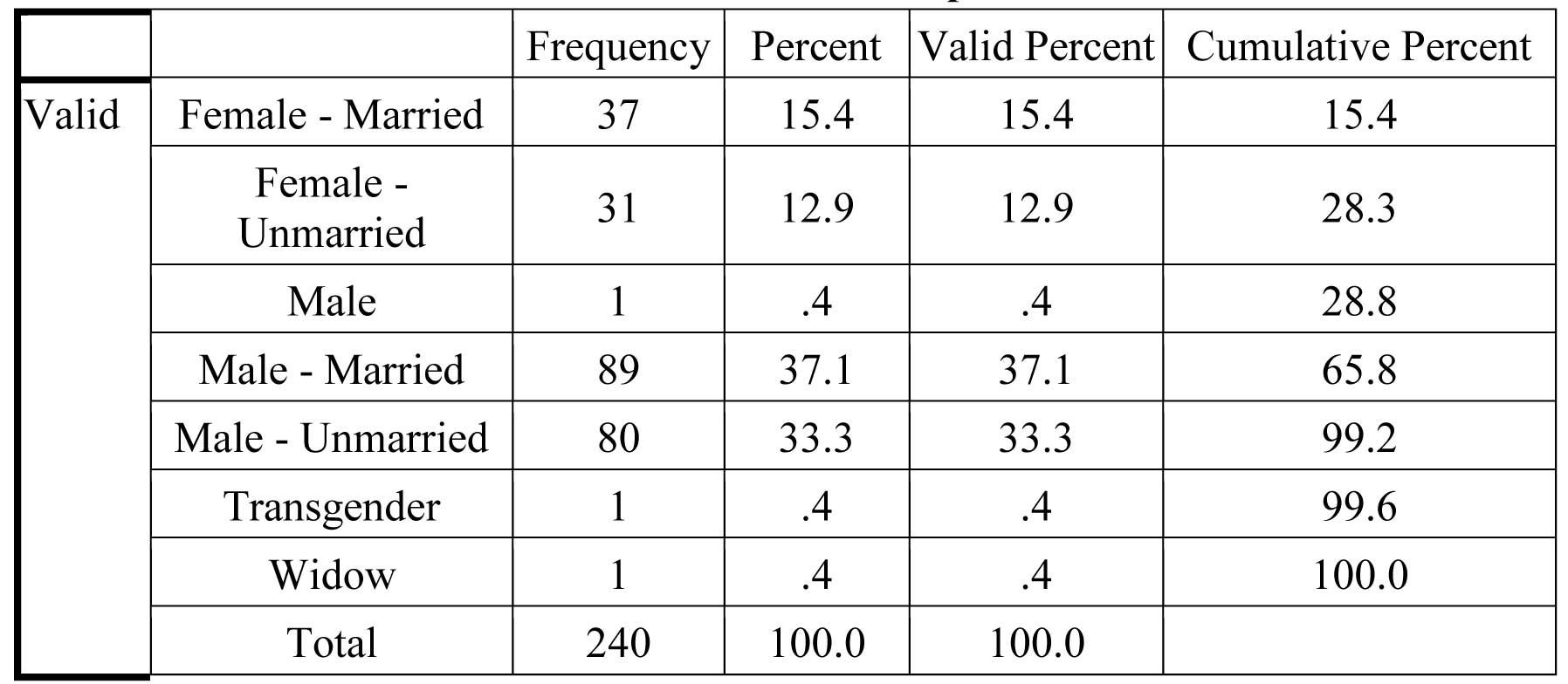
Source: Field Survey
Age of the Respondents:
Table 2 specifies that, most of the respondents covered in the research work were young respondents between 18 to 30 years age group (44.6 %), followed by middle aged between 31 to 50 years age group were 35.4 percent. The percentage of Old (Above 51 years) respondents engaged in survey was reasonably very less (20.0 %).
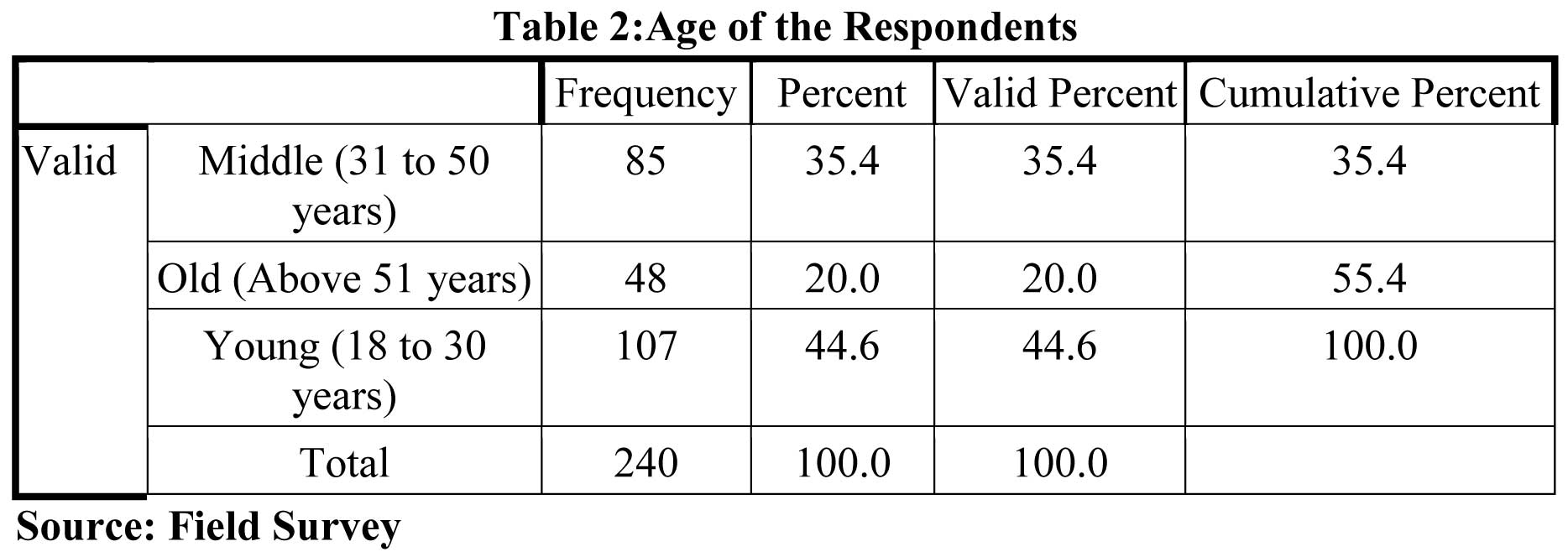
Education or Literacy Status of the Respondents:
From the Table 3, it reveals that nearly 34.6% of the respondents had received educated up to graduation level. 32.5 percent of the respondents had received Post graduation level education. 17.5 percent of the respondents had received Undergraduate level education. 9.6 percent of the respondents had received High school (11 to 12) level education. 2.9 percent of the respondents had received Secondary/ Middle school (6 to 10) level education. 2.1 percent of the respondents had received Doctorate level education.0.8 percent of the respondents had received Primary school (Up to 5) level education. In total, practically 69.2 percent of the respondents had received graduation and above level of education out of the total 240 respondents.
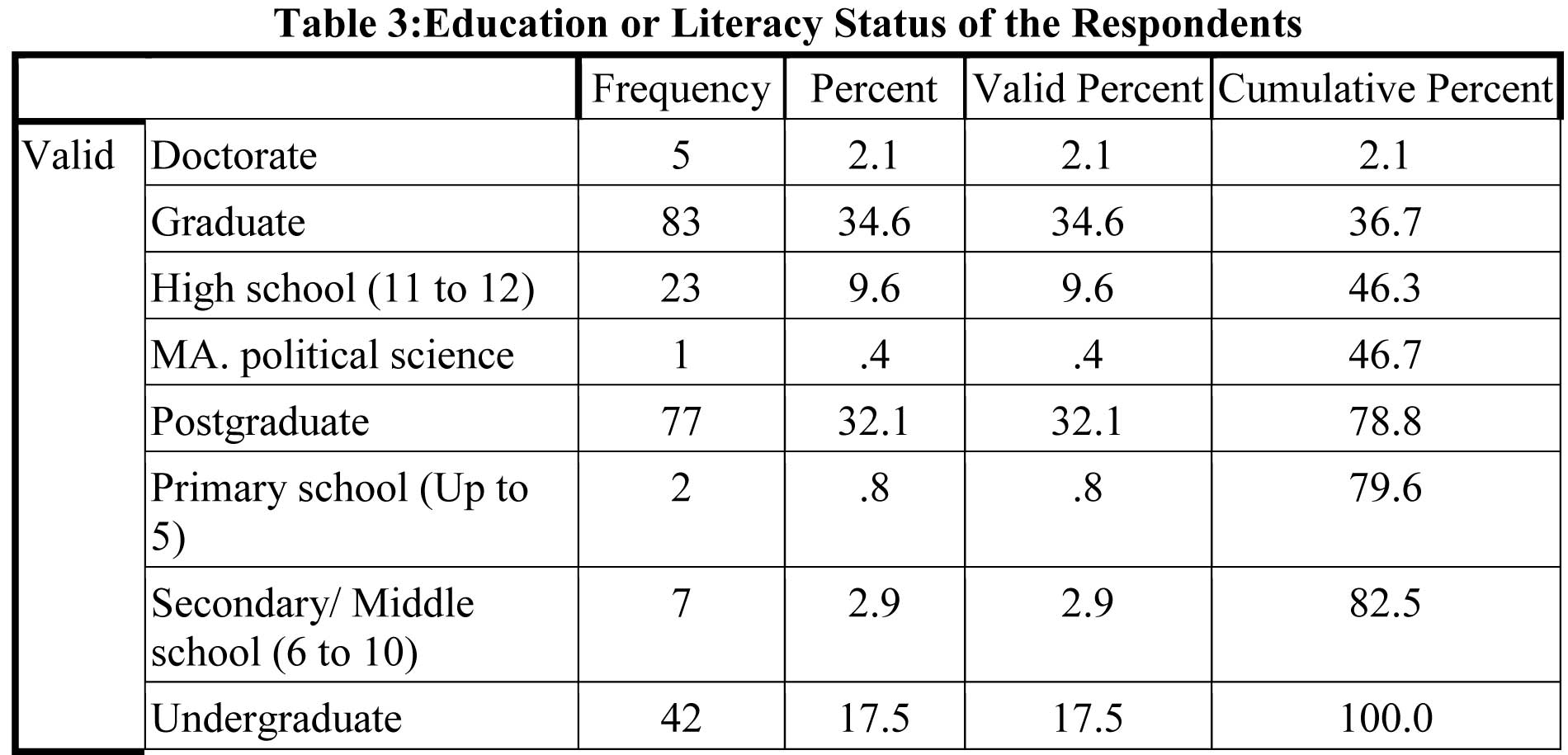
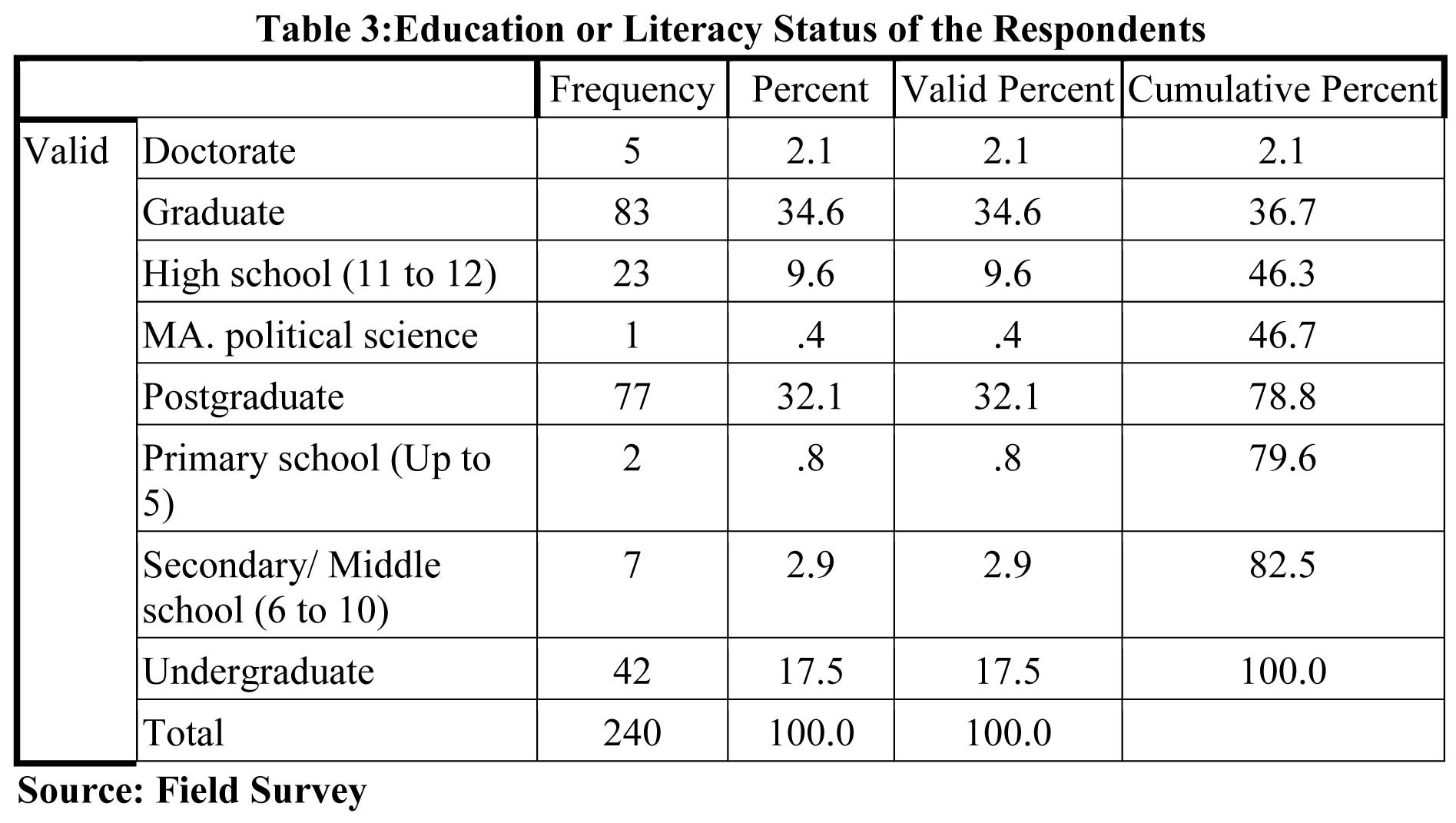
Occupational status or Type of Job of the Respondents:
Out of the total 240 sample size, it was found that 22.5 percent respondents were salaried from State Government, 20.8 percent respondents were students of different colleges and universities in Tripura, 19.3 percent respondents were self-employed covering profession like private tutor, farmer, business men etc., 18.3 percent respondents were salaried persons with private companies,7.5 percent respondents were retired persons from different organizations, 5.1 percent respondents were educated house wife,4.5 percent respondents were salaried with different Central Government organizations,1.2 percent respondents were educated unemployed. The same can be noticed from the Table 4
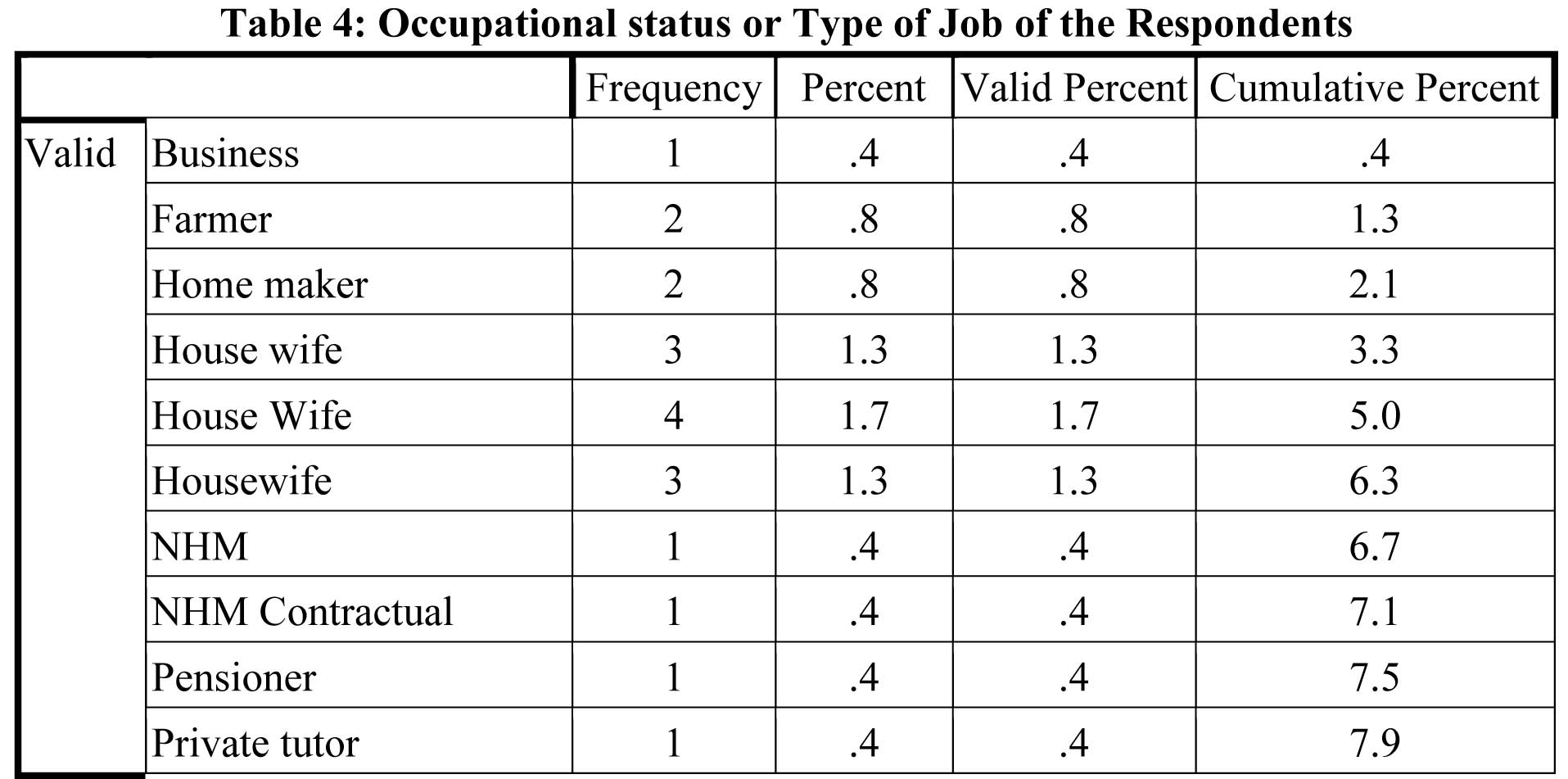

Public service advertising observation experiences related to advertising on Health care service sector of the Respondents:
Overall, 47.5 percent of the respondents have medium (5 to 10 years) Public service advertising observation experiences related to advertising on health care service sector, 32.5 percent of the respondents have below five 5 years (low) of Public service advertising observation experiences related to advertising on health care service sector and 20.0 percent of the respondents have high (11 Years and above) Public service advertising observation experiences related to advertising on health care service sector which is negligible and exceptionally less throughout the whole survey areas from the total 240 sample size.
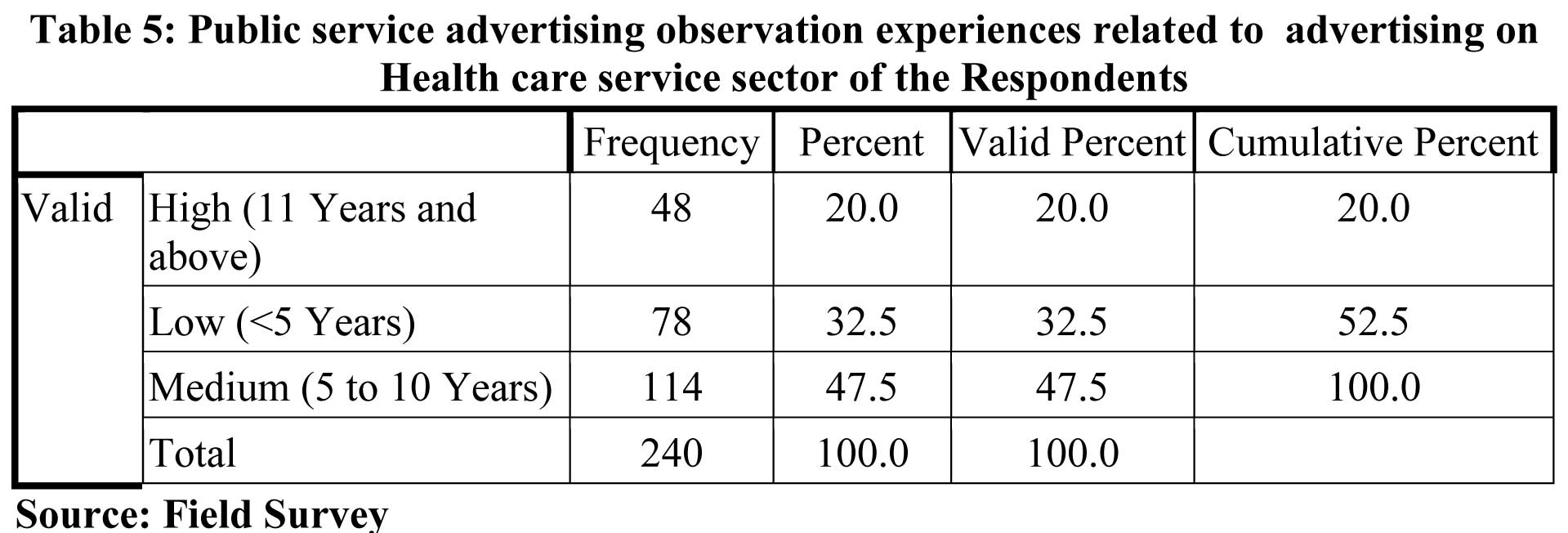
Health care service sector related public service advertising published in the print media observation experiences of the Respondents:
In health care service sector related public service advertising published in the print media observation experiences throughout the all study areas respondents have Medium (5 to 10 Years) observation experiences which is 43.8 percent, Low (<5 Years) observation experiences of health care service sector related public service advertising published in the print media is 35.4 percent and High (11 Years and above) observation experiences of health care service sector related public service advertising published in the print media is 20.8 percent.
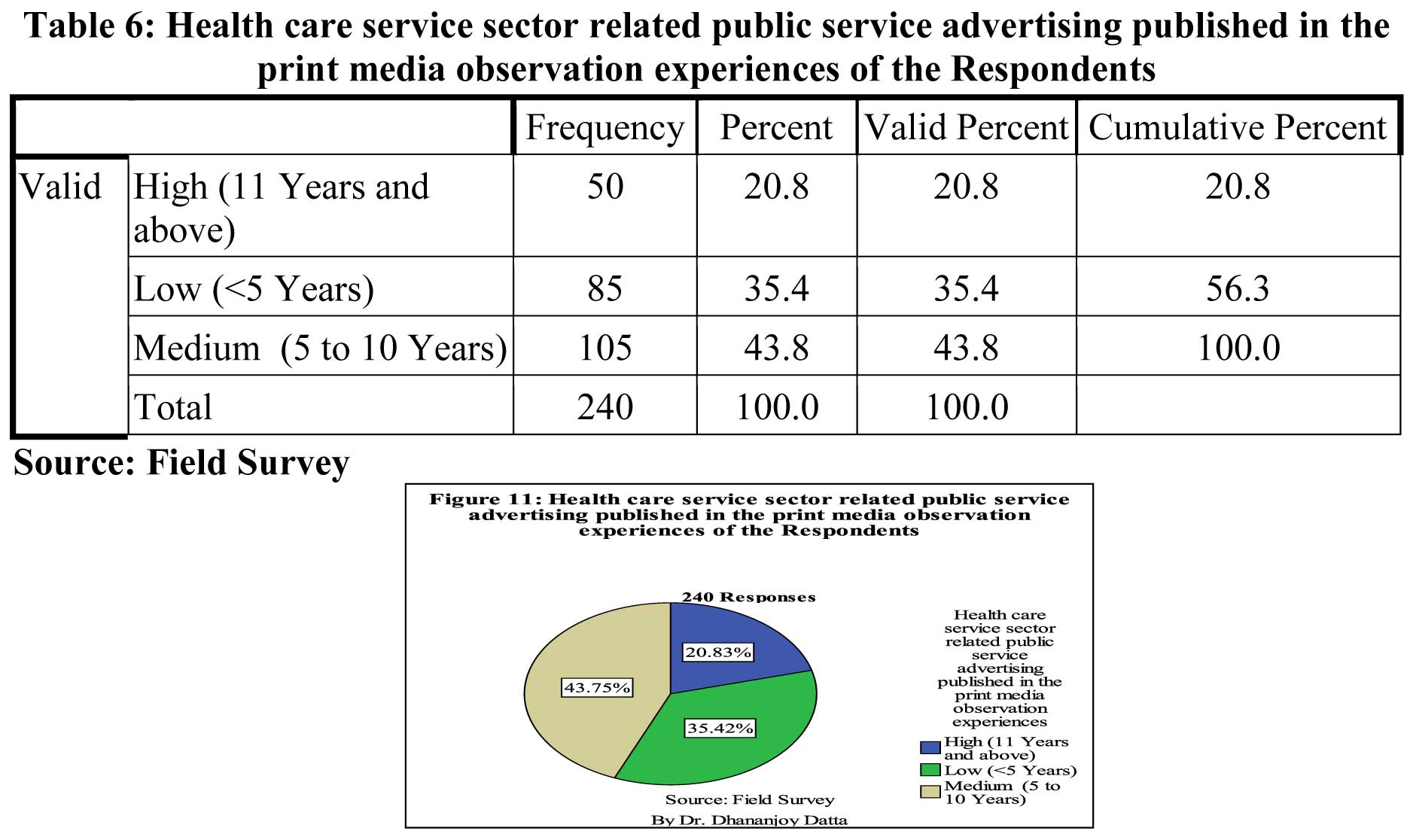
Family Monthly Income of the Respondents:
In case of respondents family monthly income in all the study areas majority was falling in Medium (10,000 above-25,000 monthly family income) income group which is 45.9percent, High (25,000 above monthly family income) income group is 27.5 percent and Low (Up to 10,000 monthly family income)income group is 26.6 percent only. The same can be seen in Table 7
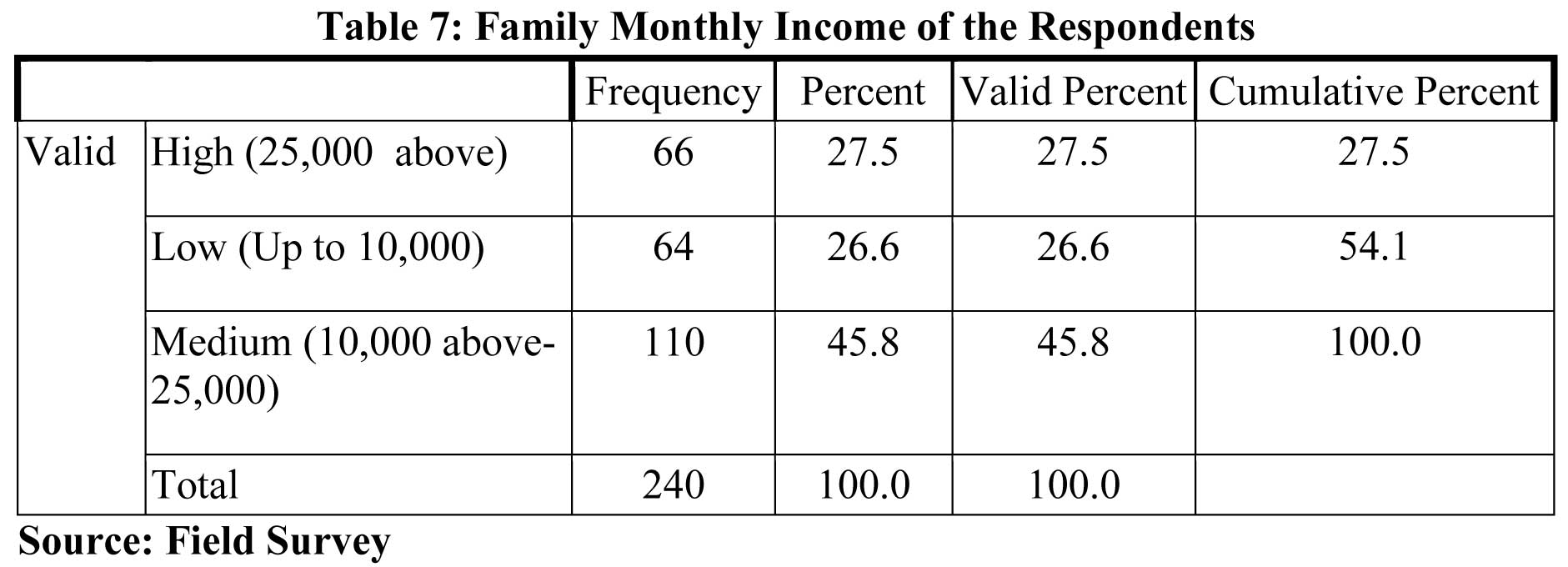
Hypotheses analysis:
The important demographic profile and socio-economic characteristics data of the 240 respondents from all eight districts which were corresponding to Gender of the respondents, Age of the respondents, Education or Literacy Status, Occupational status or Type of Job, Family Monthly income, Land Ownership in Area and Types of Property Holding were cross-tabulated [Chi square (x2) with the four main nature of observation of Public service advertising observation experiences of the respondents related to advertising on Health care service sector, Health care service sector related public service advertisement telecasted in television observation experiences of the respondents, Health care service sector related public service advertising published in the print media observation experiences of the respondents and Health care service sector related public service advertising given in outdoor media observation experiences of the respondents. For this purpose, Chi square (x2) tests of independence were used. These tests establish whether two or more attributes are associated or not. The calculated value of Chi square (x2) was compared at 5% (0.05) level of significance. If the p value is less than the alpha value (0.05) then null hypotheses is rejected i.e. the attributes are associated or related but if the p value is greater than the alpha value (0.05) then alternative hypothesis is accepted i.e. the attributes are not associated or related. The phi coefficient ranges from 0 to 1 with smaller relationships being closer to 0 and larger relationships being closer to 1. Like the phi coefficient, Cramér’s V statistic ranges from 0 to 1, with higher values indicating larger strengths of associations, or effect sizes. Hence, Phi & Cramer's V were calculated to know the effectiveness, as the research objective is to examine the effectiveness of public service advertising related to advertising on health care service sector.
Table 8 Important Socio-economic characteristics of the respondents from the study areas were Cross-tabulated [Chi square tests] with Public service advertising observation experiences of the respondents related to advertising on Health care service sector and calculation of Phi & Cramer's V to measure the effect: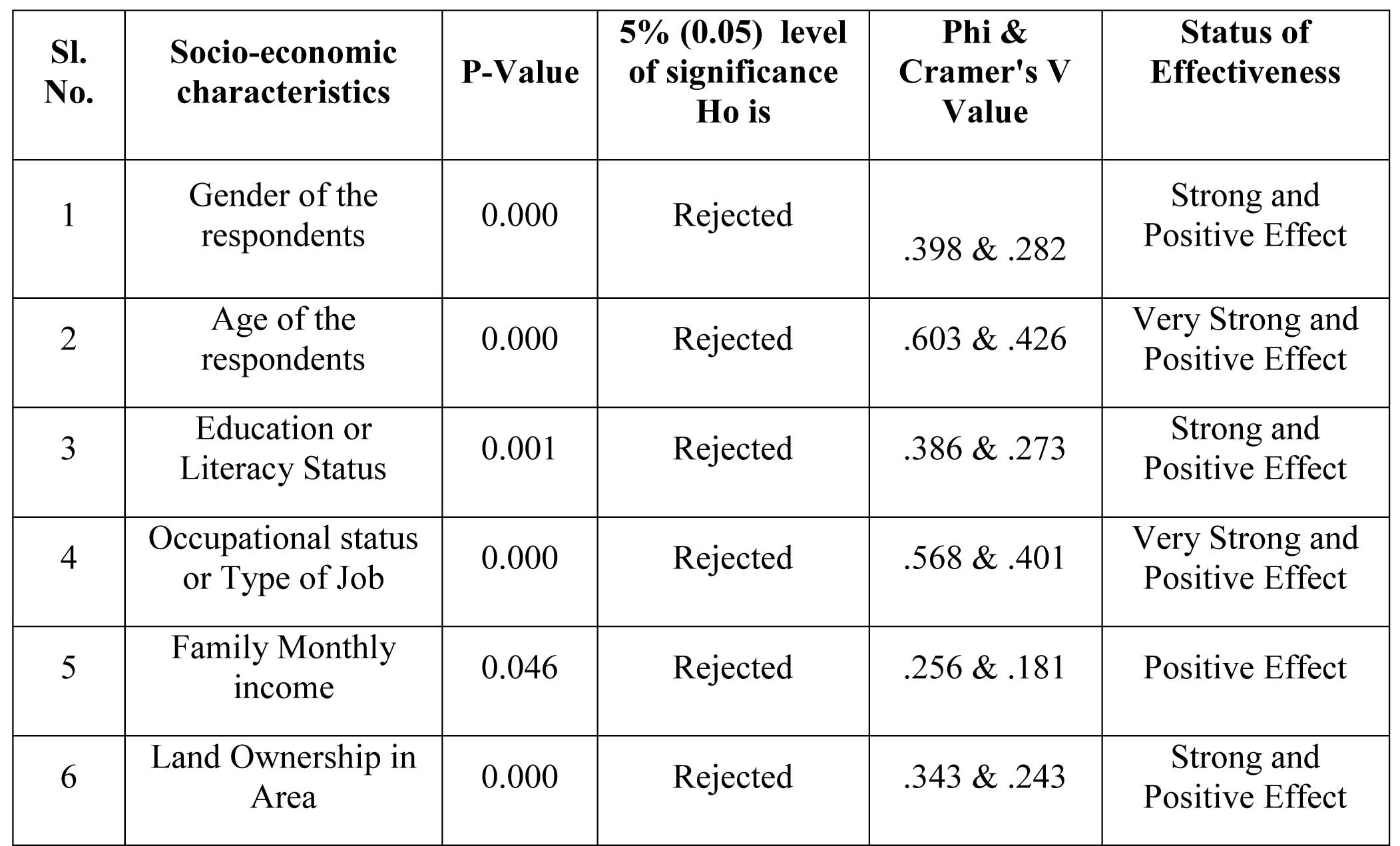

Interpretation:
Table 8 depicts that all the selected demographic profile and socio-economic characteristics like Gender of the respondents, Age of the respondents, Education or Literacy Status, Occupational status or Type of Job, Family Monthly income, Land Ownership in Area and Types of Property Holding are significantly related or associated with Public service advertising observation experiences of the respondents related to advertising on Health care service sector. From the Table 8 it also appears that the strengths of associations or effect sizes are very strong, strong and positive.
Table 8.1 Important Socio-economic characteristics of the respondents from the study areas were Cross-tabulated [Chi square x2) tests] with Health care service sector related public service advertising published in the print media observation experiences of the respondents and calculation of Phi & Cramer's V to measure the effect: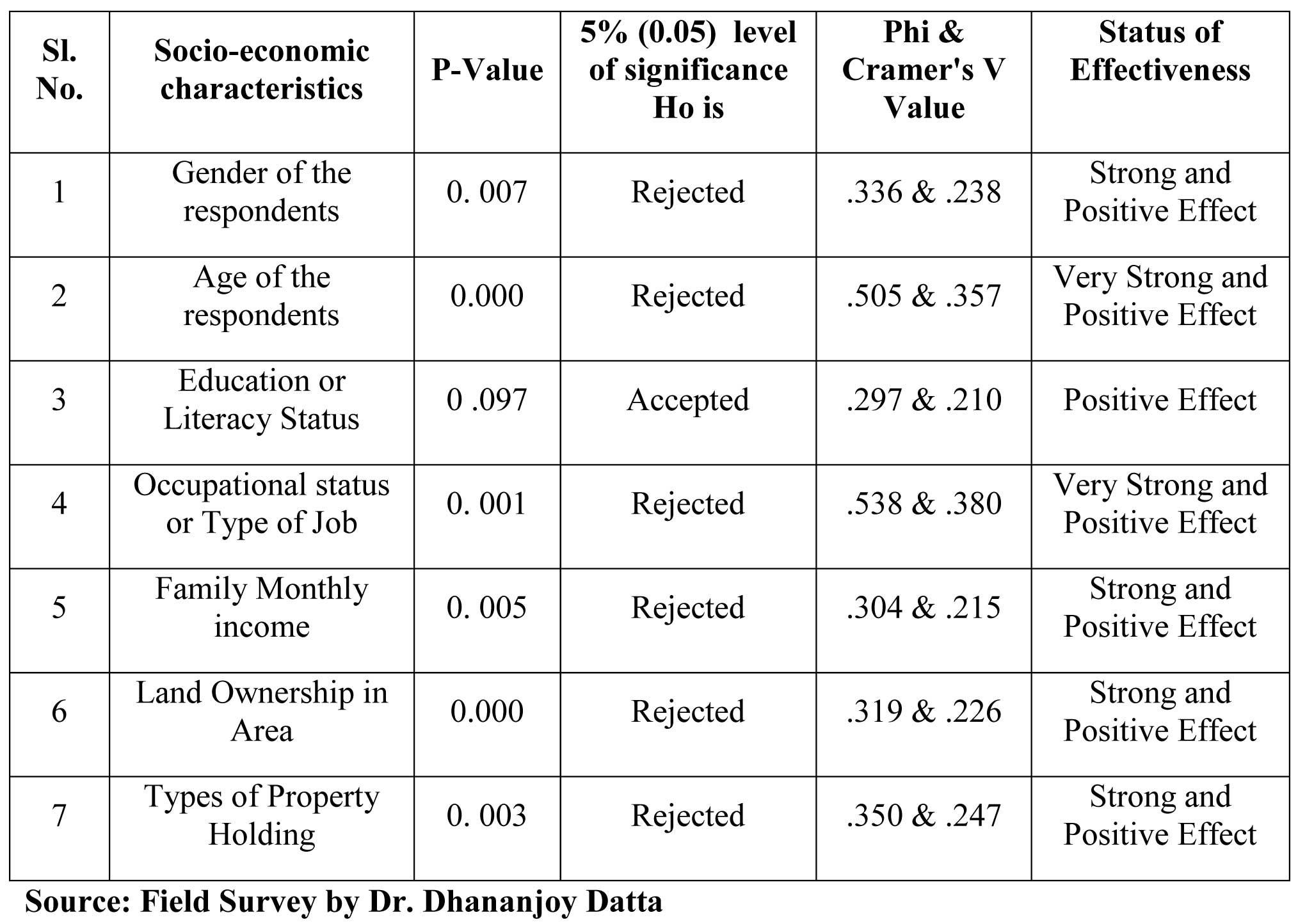
Interpretation:
Table 8.1depicts that all the selected demographic profile and socio-economic characteristics like Gender of the respondents, Age of the respondents, Occupational status or Type of Job, Family Monthly income, Land Ownership in Area and Types of Property Holding except Education or Literacy Status are significantly related or associated with Health care service sector related public service advertising published in the print media observation experiences of the respondents. From the Table 8.1, it also comes out that the strengths of associations or effect sizes are very strong, strong and positive.
Pearson Correlations involving Public service advertising observation experiences and socio-economic characteristics of the respondents:
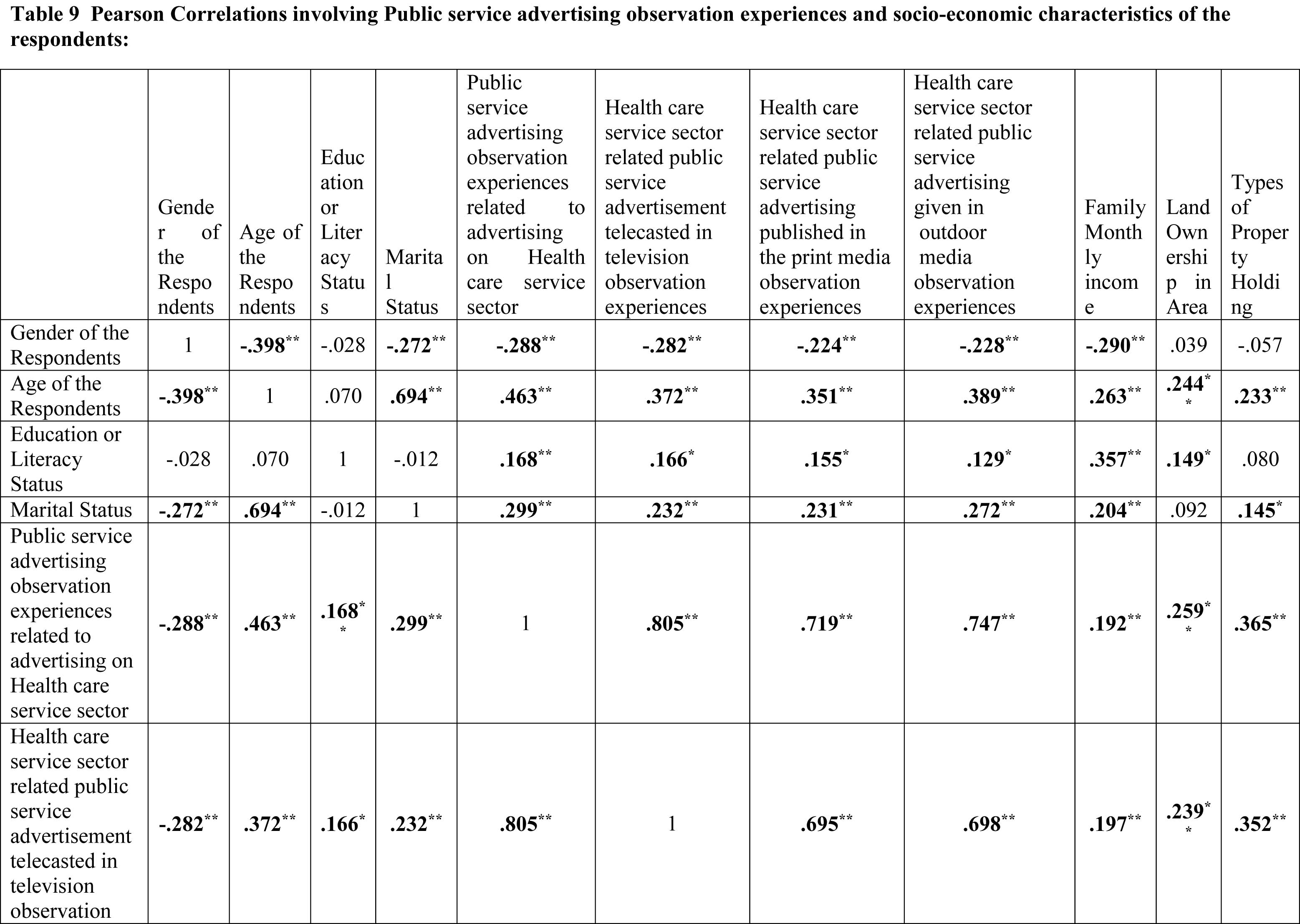

Table 9 Pearson Correlations involving Public service advertising observation experiences and socio-economic characteristics of the respondents:
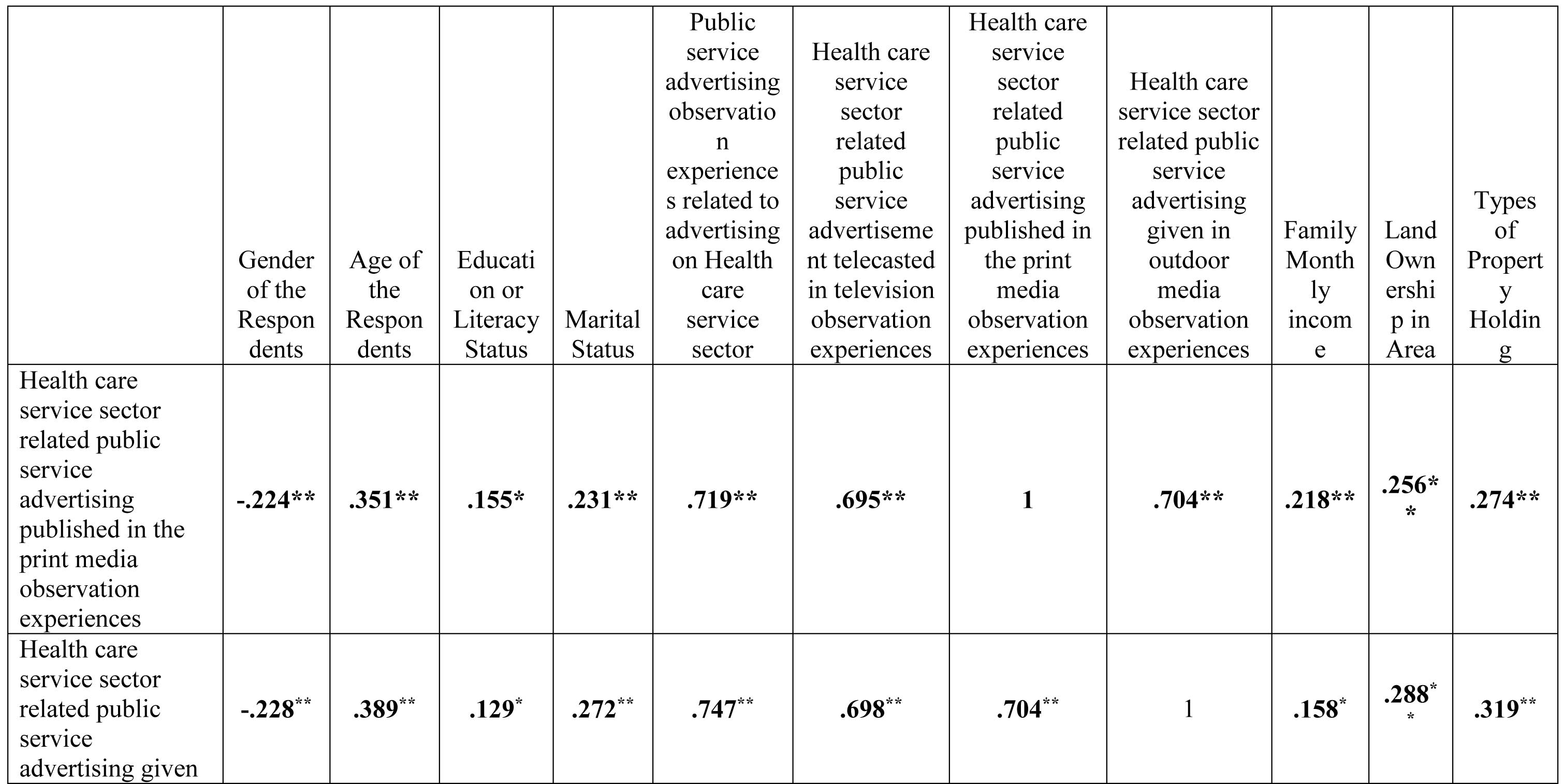

Interpretation:
Table 9 represent the Pearson Correlations involving Public service advertising observation experiences and socio-economic characteristics of the respondents. It was found that socio-economic characteristics of the respondents and Public service advertising observation experiences were very positively or negatively and significantly correlated. Table 9 indicated that Gender of the respondents were very negatively perfect and significantly correlated with Age of the respondents, Marital Status, Public service advertising observation experiences related to advertising on Health care service sector, Health care service sector related public service advertisement telecasted in television observation experiences, Health care service sector related public service advertising published in the print media observation experiences, Health care service sector related public service advertising given in outdoor media observation experiences and family monthly income at1 percent level. Age of the respondents were very negatively perfect and significantly correlated with Gender of the respondents at1 percent level and Age of the respondents were very positively and significantly correlated with Marital Status, Public service advertising observation experiences related to advertising on Health care service sector, Health care service sector related public service advertisement telecasted in television observation experiences, Health care service sector related public service advertising published in the print media observation experiences, Health care service sector related public service advertising given in outdoor media observation experiences, family monthly income, Land ownership in area and types of property holding at1 percent level. Education or Literacy Status were very positively and significantly correlated with Public service advertising observation experiences related to advertising on Health care service sector and family monthly income at1 percent level and Health care service sector related public service advertisement telecasted in television observation experiences, Health care service sector related public service advertising published in the print media observation experiences, Health care service sector related public service advertising given in outdoor media observation experiences and Land ownership in area correlated at 5 percent level. Marital Status were very negatively perfect and significantly correlated with Gender of the respondents at1 percent level and Marital Status were very positively and significantly correlated with Age of the respondents, Public service advertising observation experiences related to advertising on Health care service sector, Health care service sector related public service advertisement telecasted in television observation experiences, Health care service sector related public service advertising published in the print media observation experiences, Health care service sector related public service advertising given in outdoor media observation experiences and family monthly income at1 percent level. Marital Status also very positively and significantly correlated with types of property holding at 5 percent level. Public service advertising observation experiences related to advertising on Health care service sector were very negatively perfect and significantly correlated with Gender of the respondent’s at1 percent level and were very positively and significantly or highly correlated with all other variable under study at1 percent level. Health care service sector related public service advertisement telecasted in television observation experiences were very negatively perfect and significantly correlated with Gender of the respondent’s at1 percent level and were very positively and significantly or highly correlated with all other variable under study at1 percent level. Further, Health care service sector related public service advertising published in the print media observation experiences were very negatively perfect and significantly correlated with Gender of the respondent’s at1 percent level and were very positively and significantly or highly correlated with all other variable under study at1 percent level except education or literacy status which is correlated at 5 percent level. Health care service sector related public service advertising given in outdoor media observation experiences were very negatively perfect and significantly correlated with Gender of the respondent’s at1 percent level and were very positively and significantly or highly correlated with all other variable under study at1 percent level except education or literacy status and Family Monthly income which is correlated at 5 percent level. Family Monthly income were very negatively perfect and significantly correlated with Gender of the respondent’s at1 percent level and were very positively and significantly or highly correlated with all other variable under study at1 percent level except Health care service sector related public service advertising given in outdoor media observation experiences which is correlated at 5 percent level and only there is no relation with types of property holding. Similarly, Land ownership in area were very positively and significantly or highly correlated with all variable under study at1 percent level except Education or Literacy Status which is correlated at 5 percent level and only there is no relation with Gender of the respondent’s and Marital Status. Lastly, types of property holding were very positively and significantly or highly correlated with all variable under study at1 percent level except Marital Status which is correlated at 5 percent level and there is no relation with Gender of the respondent’s, Education or Literacy Status and Family Monthly income. Hence, from these analysis and interpretation it is absolutely clear that Public service advertising observation experiences and socio-economic characteristics of the respondents were significantly or highly correlated.

Interpretation:
Figure 12 noticeably signify that the electronic media, print media and outdoor media is popular in disseminating the public service advertising related to health care service sector. All of these media contribution is significantly required.
Figure 13.: Health care service sector related public service advertising published in the print media is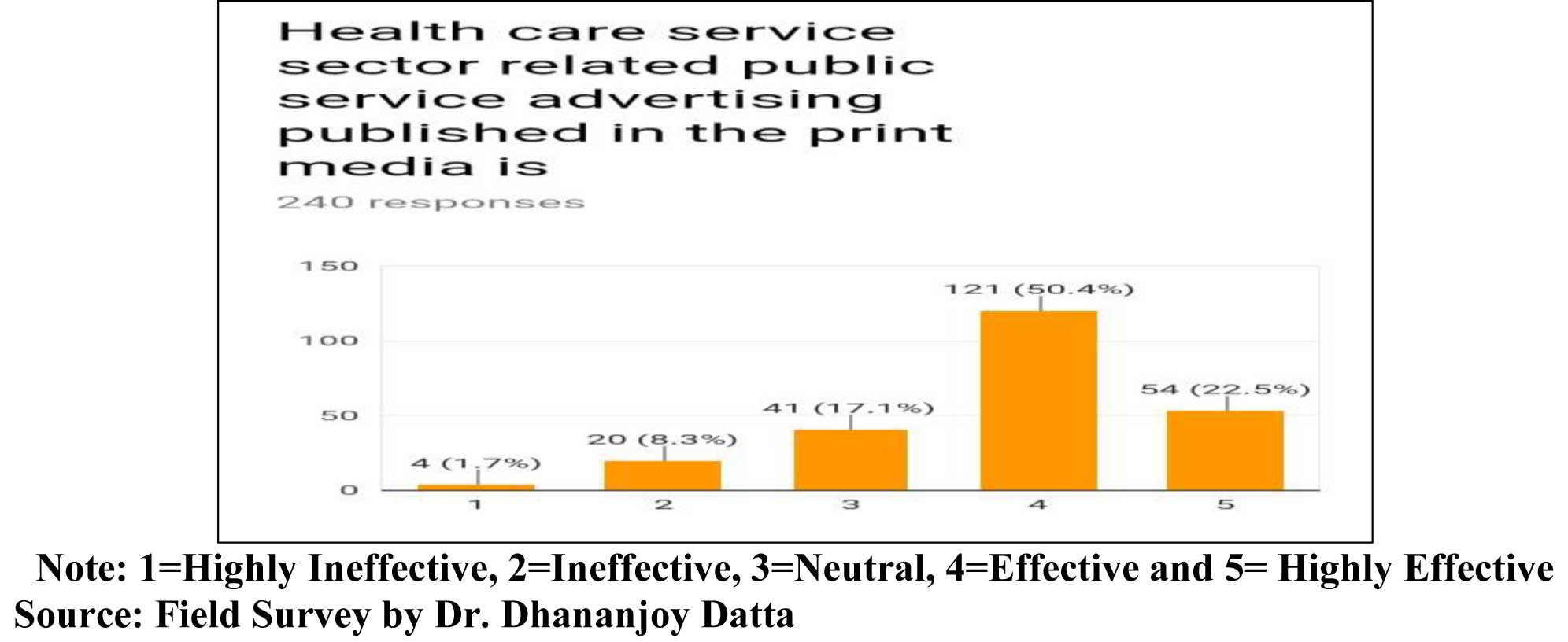
Interpretation:
Figure 13 represent the respondents’ observation about the effectiveness of health care service sector related public service advertising published in the print media and it was ascertain that 50.4 percent respondents point out that health care service sector related public service advertising published in the print media were effective,22.5 percent respondent point out that health care service sector related public service advertising published in the print media were highly effective,17.1 percent respondent were neutral, 8.3 percent respondent point out that the advertisements were ineffective and only 1.7 percent respondent indicate that the advertisements were highly ineffective which confirms the effectiveness of health care service sector related public service advertising published in the print media.
Figure 14: Overall Public service advertising related to Health care service sector is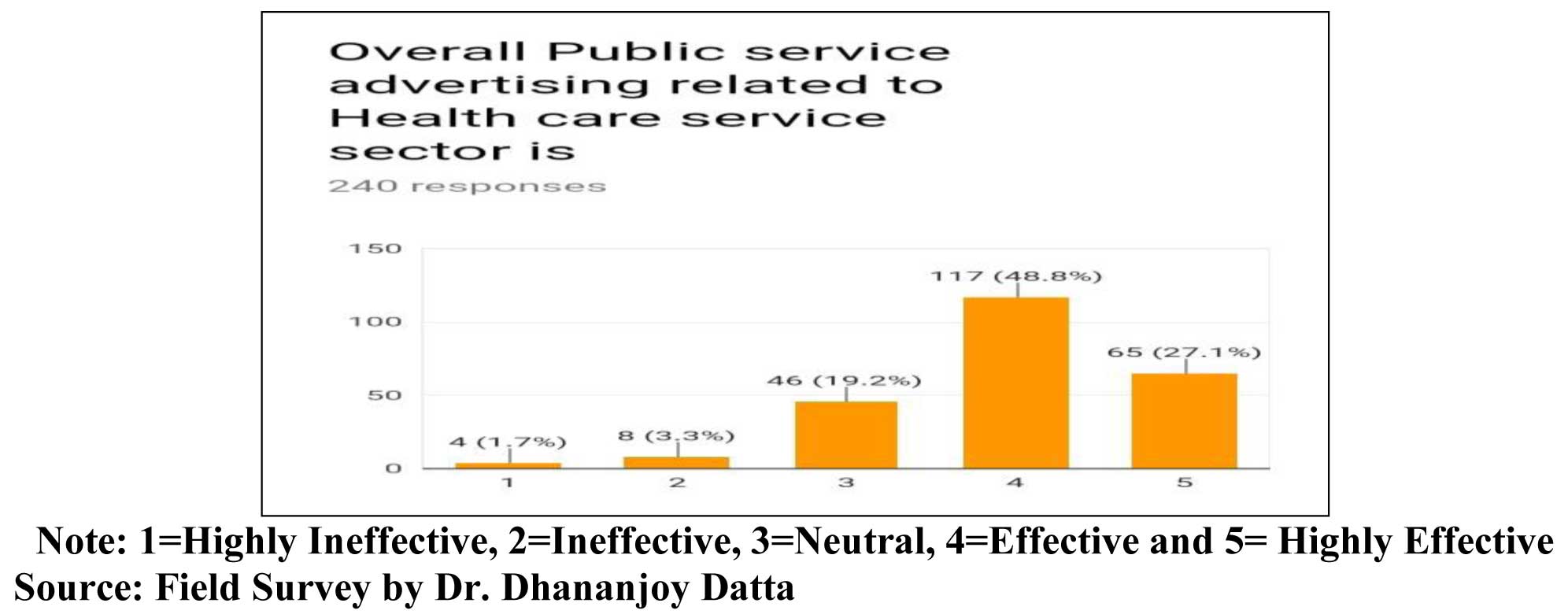
Interpretation:
Figure 14 shows the respondents’ opinion about the overall effectiveness of public service advertising related to health care service sector and it was found that 48.8 percent respondents mention that overall public service advertising related to health care service sector were effective, 27.1 percent respondent indicate that overall public service advertising related to health care service sector were highly effective,19.2 percent respondent were neutral, 3.3 percent respondent point out that the advertisements were ineffective and only 1.7 percent respondent indicate that the advertisements were highly ineffective which substantiates the overall effectiveness of public service advertising related to health care service sector.
Findings, Summarizations and Concluding Observation:
Chi square x2) test, Phi & Cramer's V analysis through Table 5.2.1 depicts that all the selected demographic profile and socio-economic characteristics like Gender of the respondents, Age of the respondents, Education or Literacy Status, Occupational status or Type of Job, Family Monthly income, Land Ownership in Area and Types of Property Holding are significantly related or associated with Public service advertising observation experiences of the respondents related to advertising on Health care service sector. From the Table 8 , it also appears that the strengths of associations or effect sizes are very strong, strong and positive. Table 8.1 depicts that all the selected demographic profile and socio-economic characteristics like Gender of the respondents, Age of the respondents, Occupational status or Type of Job, Family Monthly income, Land Ownership in Area and Types of Property Holding except Education or Literacy Status are significantly related or associated with Health care service sector related public service advertising published in the print media observation experiences of the respondents. From the Table 8 it also comes out that the strengths of associations or effect sizes are very strong, strong and positive. Pearson Correlations analysis and interpretation makes it absolutely clear that Public service advertising observation experiences and socio-economic characteristics of the respondents were significantly or highly correlated. Hence, from the whole analysis of the study it can be strongly conclude that the public service advertising related to advertising on health care service sector through print media is effective and it is observed that all the study have provided some positive outcome and further expansion of field study frequently basis may give more effective and efficient social wellbeing’s.
Interpretation:
I am very much thankful and express my gratitude to the each and every individual whose valuable contribution, guidance and consultancy involved in the preparation of Published report, Web Articles, Journals and research report etc. which makes me aware about the literature for the economics of public service advertising of health care service sector from the secondary sources used in the study. I am also thankful to all the respondents who have spent their valuable time for filling up the questionnaires.
References:
- Bhatia, K. T. (2009). Advertising and Marketing in Rural India. Macmillan Publishers India Limited.
- Chadha,A., Mehdi,A., and Malik, G. (2007). Working Paper No. 198 on “Impact of Preventive Health Care on Indian Industry and Economy.” http://www.icrier.org/pdf/Working%20Paper%20198.pdf (Retrieved on 20/10/2016 at 12.30 pm)
- Clayforth C, Pettigrew S, Mooney K, Lansdorp-Vogelaar I, Rosenberg M, Slevin T. (2014). a study on cost-effectiveness analysis of online, radio and print tobacco control advertisements targeting 25-39 year-old males. Australian and New Zealand Journal of Public Health. 2014 vol. 38 no. 3. Pp.270-274. (http://www.ncbi.nlm.nih.gov/pubmed/24750454. Accessed on 04/07/2016 at 3.30 pm)
- Definition of Health Economics. https://en.wikipedia.org/wiki/Health_economics (Retrieved on 22th April’2016 at 10.35 am). 5. Definition of Public service advertising. http://www.wisegeek.com/what-is-public-service-advertising.htm (Retrieved on 22th April’2016 at 10.50 am).
- Department of Industrial Policy and Promotion (DIPP), RNCOS Reports, Media Reports, Press Information Bureau (PIB). http://www.ibef.org/industry/healthcare-india.aspx (Retrieved on 22th April’2016 at 10 am).
- Elder W R et al. ( 2004). Effectiveness of Mass Media Campaigns for Reducing Drinking and Driving and Alcohol-Involved Crashes. American Journal of Preventive Medicine. 0749-3797/04/$–see front matter. doi:10.1016/j.amepre.2004.03.002. Published by Elsevier Inc. https://www.thecommunityguide.org/mvoi/massmedia_AJPM.pdf ( Retrieved on 11/07/2016 at 11.00 am)
- Farrelly C M, Hussin A, and Bauer E U. (2007). Effectiveness and cost effectiveness of television, radio and print advertisements in promoting the New York smokers' quitline. Tobacco Control. 16(Suppl 1): PP21–23. doi: 10.1136/tc.2007.019984 (http://www.ncbi.nlm.nih.gov/pmc/articles/PMC2598515/ Accessed on 07/07/2016 at 8.00 pm)
- Flora, J. A., & Maibach, E. (1990). Cognitive responses to AIDS information: The effects of issue, involvement and message appeal. Communication Research. vol.17 no.6 759-774.doi: 10.1177/009365029001700603 http://crx.sagepub.com/content/17/6/759.abstract (Retrieved on 26/10/2016 at 02.30 pm)
- Health Care Sector Growth Trend and Figure and Per capita HealthCare Expenditure. http://www.ibef.org/industry/healthcare-presentation (Retrieved on 22th April’2016 at 10.30 am).
- Hinde S et al. (2015). Modeling the cost-effectiveness of public awareness campaigns for the early detection of non-small-cell lung cancer. Retrieved October 30, 2016 at 3 pm from https://www.ncbi.nlm.nih.gov/pubmed/26010412 .
doi: 10.1038/bjc.2015.167.
